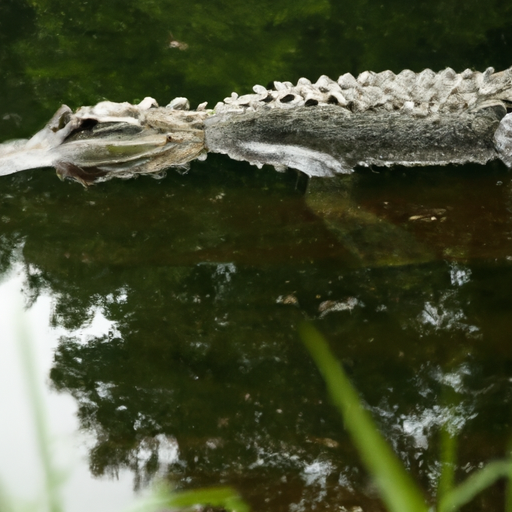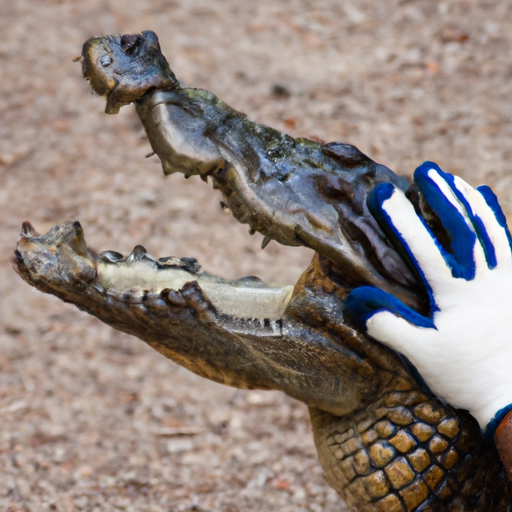Welcome to our fascinating exploration of the presence of alligators in China, specifically focusing on the Chinese alligator.
Have you ever wondered why these incredible creatures thrive in a land known for its diverse wildlife? We’ll dive into the alligator population in China, their habitats, behavior, and the ongoing conservation efforts dedicated to protecting these magnificent reptiles.
Alligators are present in China due to the existence of the Chinese alligator, a species endemic to the country, specifically found in the province of Anhui. Conservation efforts, including captive breeding and reintroduction programs, aim to protect and increase the population of these critically endangered alligators.
Key Takeaways:
- The Chinese alligator is a crocodilian endemic to China and is related to the American alligator.
- They have a dark gray or black coloration, fully armored body, and primarily feed on fish and invertebrates.
- Their range is restricted to six regions in the province of Anhui, with approximately 300 individuals remaining.
- Conservation efforts aim to protect and increase the population of Chinese alligators through captive breeding and reintroduction programs.
- The Chinese alligator holds historical and cultural significance in Chinese literature and beliefs.
Chinese Alligator Conservation Efforts in Anhui Province
In 2001, the State Forestry Administration launched the Chinese Alligator Protection and Release Project in Anhui Province as part of alligator conservation efforts in China.
This project aimed to increase the population of Chinese alligators by releasing captive-bred individuals into the wild.
The Anhui Chinese Alligator National Nature Reserve and Changxing Yinjiabian Chinese Alligator Nature Reserve have played active roles in these conservation initiatives.
Since 2003, a total of 108 alligators have been released through relocation projects, contributing to the growth of the alligator population in China.
In 2019, a five-year release plan was initiated with the goal of releasing 1,500 alligators into their natural habitats.
Within the first two years of the plan, 1,300 individuals were successfully reintroduced. These captive-bred alligators have adapted well to the natural environment, enabling natural breeding and contributing to the population growth of Chinese alligators.
To support the conservation efforts, the Chinese Alligator National Nature Reserve in Anhui Province has been established.
This reserve provides a protected habitat for the alligators and helps ensure their survival.
Additionally, the Changxing Yinjiabian Chinese Alligator Nature Reserve has been actively engaged in conservation programs to preserve the species’ habitats, promote breeding, and protect the alligators from threats.
Historical Significance of Chinese Alligators
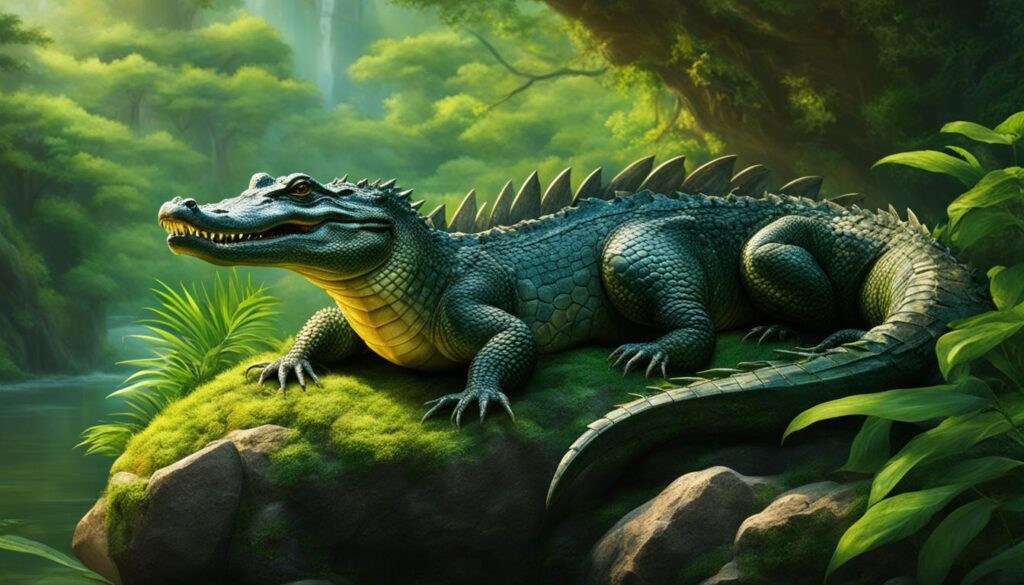
The Chinese alligator, a fascinating species endemic to China, holds great historical and cultural significance.
This remarkable creature has been referenced in Chinese literature since the third century and is closely associated with the Chinese dragon, a powerful symbol deeply rooted in Chinese culture.
In the late 1200s, the renowned explorer Marco Polo became the first person outside of China to document the existence of the Chinese alligator.
His accounts brought attention to this remarkable creature and its unique characteristics.
The Chinese alligator was held in high regard and believed to possess medicinal properties, making it highly sought after by humans.
Its meat and skin were utilized for various purposes, further adding to its cultural significance.
Due to its remarkable features and cultural significance, the Chinese alligator has served as an inspiration for various artworks and writings.
It has become intricately linked to the depiction of the Chinese dragon, a creature associated with power, wisdom, and good fortune.
To visualize the connection between the Chinese alligator and Chinese culture, consider the image below:
This image highlights the association between the Chinese alligator, the magnificent dragon, and their shared cultural significance.
Habitat and Range of the Chinese Alligator
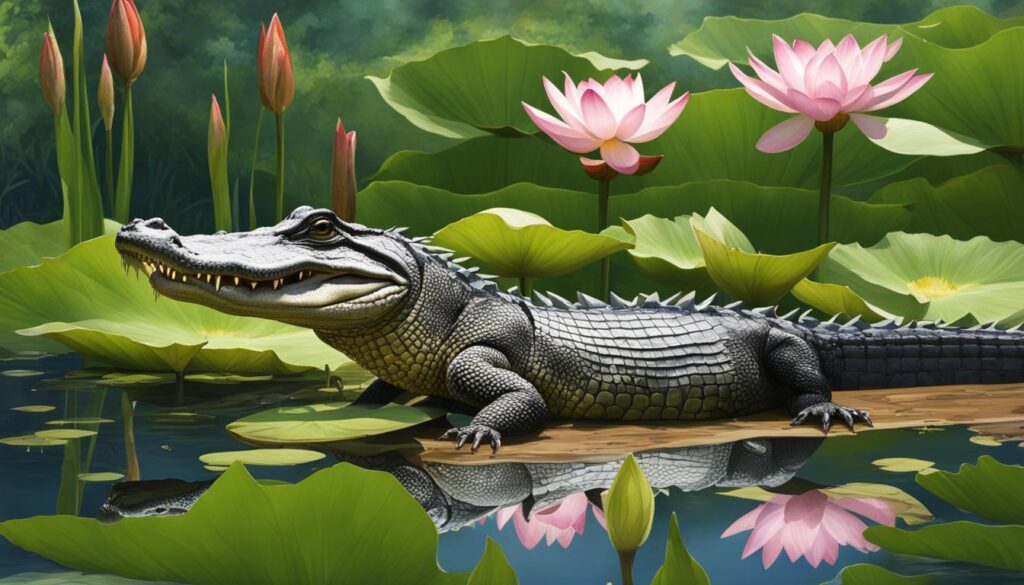
The Chinese alligator, also known as the Yangtze alligator or muddy dragon, thrives in bodies of fresh water throughout its restricted range in China.
This critically endangered species is primarily found in six regions within the province of Anhui.
These regions include Jingxian, Langxi, Guangde, Nanling, as well as the Xuanzhou district of Xuancheng city.
Originally, the Chinese alligator had a wider range that extended to areas such as Japan.
However, due to habitat destruction and other factors, its population and range have significantly declined over time.
As a result, conservation efforts have been intensified to protect the remaining habitats and promote population recovery.
Unique Characteristics of the Chinese Alligator
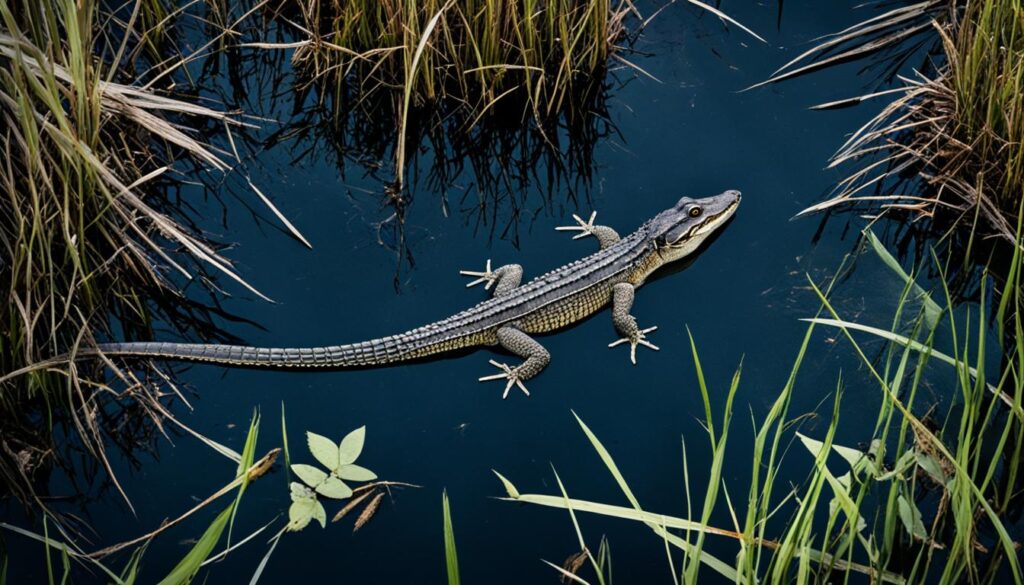
The Chinese alligator, a small species of crocodilian, possesses distinct features that set it apart from other species. Let’s explore the unique traits of this fascinating creature.
Size and Coloration
The Chinese alligator is one of the smallest crocodilian species, with adult individuals typically measuring between 5 feet (1.5 meters) to 7 feet (2.1 meters) in length and weighing 50 (23 kilograms) to 85 pounds (38.5 kilograms).
Its size makes it charmingly compact compared to its larger relatives. What’s more, it boasts a striking coloration of black or dark gray, further enhancing its allure.
The contrast of its color against its fully armored body contributes to its unique appearance.
Behavioral Traits
The Chinese alligator exhibits a range of intriguing behavioral traits. During winter, it enters a state called brumation, seeking shelter in burrows to conserve energy and protect itself from the cold.
In contrast, during the summer months, it becomes primarily nocturnal, taking advantage of the cooler temperatures to hunt and explore its environment.
This adaptation showcases the species’ ability to cope with varying climates and maximize its chances of survival.
Vocalization and Communication
The Chinese alligator is known for its vocal nature. During the mating season, adult alligators produce a distinctive bellowing sound to attract potential mates.
These deep roars reverberate through their habitats, signaling their presence and desire to reproduce.
Additionally, juvenile alligators vocalize to communicate with their parents and other young alligators, establishing social bonds and navigating their surroundings effectively.
Lifespan
The lifespan of the Chinese alligator is an impressive aspect of its biology. Captive specimens have been known to live for over 70 years, while wild individuals can reach beyond 50 years of age.
This longevity allows these creatures to contribute to their ecosystem and engage in long-term ecological interactions.
Their extended lifespans pair perfectly with their conservation efforts, ensuring future generations can appreciate the splendor of the Chinese alligator.
As we delve into the unique characteristics of the Chinese alligator, we are in awe of its size, coloration, behavioral traits, vocalization, and remarkable lifespan.
These attributes make this crocodilian species an exceptional creature worthy of preservation and admiration.
Genetic Diversity and Conservation Challenges
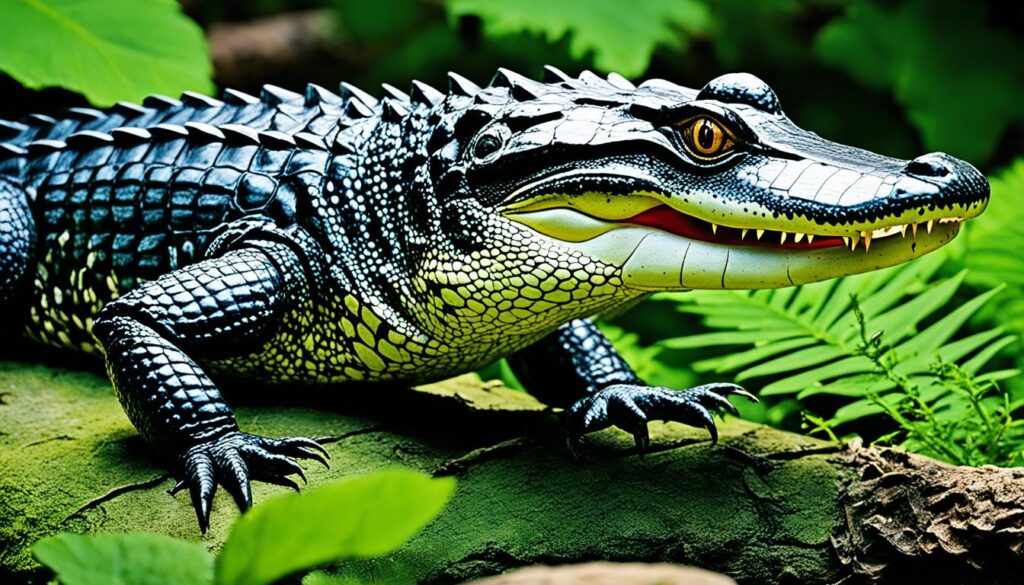
The Chinese alligator, with its declining population and limited gene pool, faces significant challenges in maintaining genetic diversity.
Over the past 20,000 years, the effective population size of the three existing populations has steadily decreased.
This decline has led to extremely low genetic diversity, the presence of long runs of homozygous fragments, and an increased mutational load across the genome.
Conservation efforts are underway to address these challenges and ensure the long-term survival of the species.
One strategy is genetic rescue, which involves translocating individuals from other populations to increase genetic diversity and minimize the negative effects of inbreeding.
By introducing new genetic material, genetic rescue aims to restore the viability and adaptability of the Chinese alligator populations.
Genetic rescue is a crucial component of conservation programs, as it helps combat the loss of genetic diversity and enhances the overall health and resilience of the species.
By introducing individuals from different populations, genetic rescue mitigates the inbreeding depression and improves the genetic fitness of the Chinese alligator population.
The Importance of Genetic Diversity
Genetic diversity plays a vital role in the survival and adaptability of a species. It allows populations to withstand environmental changes, resist diseases, and maintain overall fitness.
In the case of the Chinese alligator, the decline in genetic diversity poses a threat to its long-term survival.
Low genetic diversity increases the risk of inbreeding, which can lead to decreased fertility, higher susceptibility to diseases, and reduced adaptability to changing conditions.
Without intervention, the declining population trend and inbreeding may further compromise the genetic health of the Chinese alligator and hinder its ability to recover.
The Role of Conservation Challenges
The conservation challenges faced by the Chinese alligator highlight the urgency of implementing effective preservation strategies.
These challenges include habitat destruction, fragmentation, and human activities that threaten the species’ survival.
Climate change and pollution also contribute to the declining population.
Conservation efforts must address these challenges holistically, combining habitat restoration, genetic rescue programs, and public awareness campaigns.
By restoring and protecting the alligator’s natural habitats, promoting genetic diversity, and creating public support for conservation initiatives, the Chinese alligator can have a brighter future.
Overall, the genetic diversity of the Chinese alligator plays a critical role in its survival and long-term conservation.
Efforts to address the challenges of declining population and inbreeding through genetic rescue are essential for ensuring the species’ viability.
By protecting the genetic health of the Chinese alligator, conservationists can contribute to the preservation of this unique and endangered species.
Economic and Ecological Importance of the Chinese Alligator
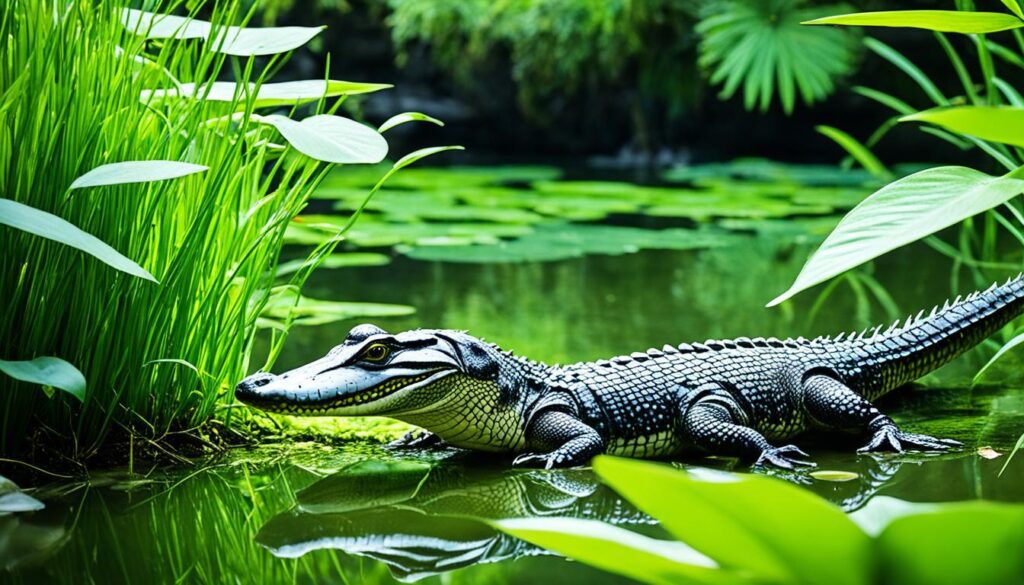
The Chinese alligator, with its presence in China’s natural landscapes, holds significant ecological and economic value.
This endangered species plays a vital role in its habitat by regulating fish populations and contributing to the balance of the ecosystem.
By controlling the number of fish, the Chinese alligator helps maintain the health of wetlands and promotes biodiversity.
As a top predator, it helps prevent overpopulation of certain fish species and ensures the overall stability of the aquatic ecosystem.
Furthermore, the Chinese alligator provides various ecosystem services that benefit the environment and human societies.
Its presence in wetland habitats helps purify water by filtering out pollutants and improving water quality.
This not only benefits other aquatic species but also supports the well-being of local communities.
In addition to its ecological role, the Chinese alligator holds economic value. Conservation efforts focused on protecting this unique species have attracted tourists who are interested in observing these ancient reptiles in their natural habitat.
The growing popularity of eco-tourism initiatives centered around the Chinese alligator has contributed to the local economy, providing income and employment opportunities for nearby communities.
The conservation benefits of protecting the Chinese alligator extend beyond its economic value.
Preserving this endangered species helps safeguard the overall biodiversity of the region, preserving the delicate balance of the ecosystem and contributing to the conservation of cultural heritage.
Future Conservation and Research Efforts
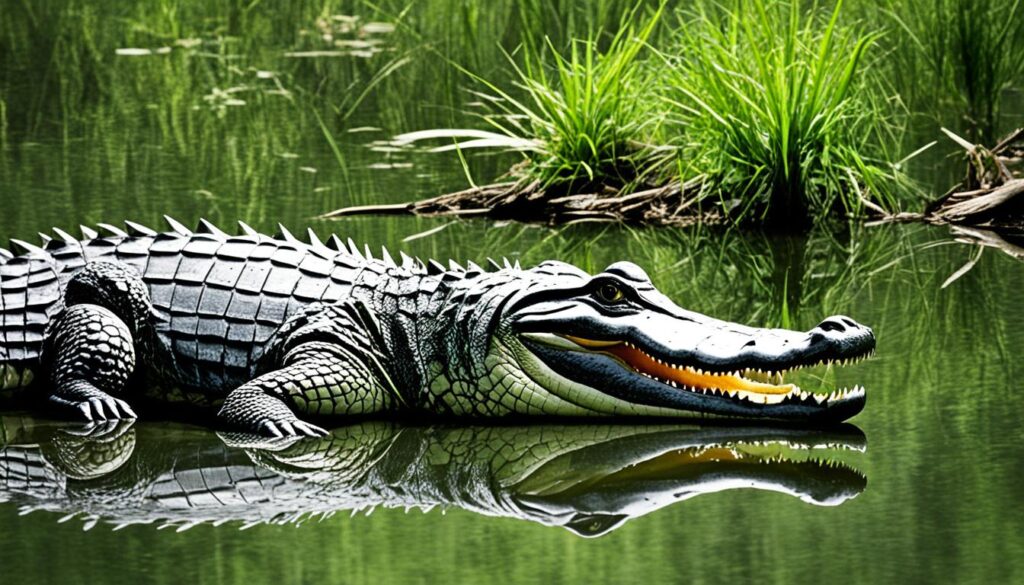
The future of alligator conservation in China relies on a comprehensive approach that encompasses habitat restoration, genetic monitoring, research initiatives, and public awareness campaigns.
These efforts are crucial for the long-term survival and protection of the Chinese alligator and its natural habitats.
Habitat Restoration
Habitat restoration projects play a vital role in creating suitable conditions for alligator populations to thrive.
By restoring and protecting their natural habitats, including bodies of fresh water, wetlands, and surrounding ecosystems, we can provide the necessary resources and shelter for the Chinese alligators to live, reproduce, and maintain a healthy population.
Genetic Monitoring
Enhanced genetic monitoring and management are critical for tracking the genetic health and diversity of Chinese alligator populations.
By monitoring their genetic profiles, we can gain valuable insights into the population dynamics, identify potential inbreeding issues, and develop strategies to preserve genetic diversity and mitigate the negative effects of inbreeding on the species.
Research Initiatives
Research initiatives focused on understanding the behavior, ecology, and genetic characteristics of the Chinese alligator are essential for developing targeted conservation measures.
By studying their natural behaviors, feeding patterns, reproductive cycles, and responses to environmental changes, we can adapt conservation strategies accordingly and ensure the long-term viability of the species.
Public Awareness
Public awareness campaigns are instrumental in garnering support for alligator conservation and promoting responsible actions from both local communities and international audiences.
By raising awareness about the importance of protecting the Chinese alligator and its habitats, we can inspire individuals, organizations, and governments to actively participate in conservation efforts and allocate resources for the species’ well-being.
Through collaborative efforts in habitat restoration, genetic monitoring, research initiatives, and public awareness, we can secure a brighter future for the Chinese alligator and ensure the preservation of this unique species in its native habitats.
Conclusion
The Chinese alligator’s presence in China underscores the critical importance of conservation efforts in safeguarding endangered species and preserving biodiversity.
Through initiatives like captive breeding, reintroduction programs, and habitat preservation, the Chinese alligator population has experienced some success.
However, continued efforts are essential to ensure its long-term survival and recovery.
With ongoing conservation programs, genetic monitoring, and public awareness initiatives, there is optimism for the future prospects of alligator conservation in China.
These efforts pave the way for the continued existence and well-being of this unique species in its native habitats.
By prioritizing alligator conservation, we can contribute to the preservation of ecosystems and the protection of biodiversity for generations to come.
Alligator conservation in China serves as an important example of the positive impact that human intervention can have on endangered species.
By nurturing and protecting the Chinese alligator population, we not only secure the future of this remarkable species but also contribute to the ecological balance and cultural heritage of the region.
Together, let us diligently work towards the continued success of alligator conservation in China.
Frequently Asked Questions
Q: Where did Chinese alligators come from?
A: Chinese alligators are native to eastern China. They are one of the two alligator species in the world, originating from and primarily found in the Yangtze River basin.
Q: How did alligators get to Asia?
A: The Chinese alligator is indigenous to Asia and did not “get” there from elsewhere. It evolved in the region millions of years ago and has been present there since prehistoric times.
Q: Are crocodiles indigenous to China?
A: Crocodiles are not indigenous to China. The primary crocodilian species native to China is the Chinese alligator. However, the saltwater crocodile might occasionally be found in the southernmost parts of China, but it is not indigenous to the region.
Q: Will Chinese alligators go extinct?
A: Chinese alligators are currently listed as critically endangered by the IUCN Red List, facing a high risk of extinction in the wild. Conservation efforts are in place to protect and increase their population.
Q: How big do Chinese alligators get?
A: Chinese alligators are relatively small compared to other crocodilian species. They typically grow to about 1.5 to 2 meters (about 5 to 7 feet) in length.
Q: What is the Chinese alligators closest relative?
A: The Chinese alligator’s closest relative is the American alligator (Alligator mississippiensis), with both species being the only members of the Alligator genus.
Q: Are Chinese alligators related to American alligators?
A: Yes, Chinese alligators are closely related to American alligators. They are both part of the Alligator genus, making them each other’s closest relatives.
Q: What is the predator of a Chinese alligator?
A: In the wild, adult Chinese alligators have few natural predators due to their size and nature. However, humans pose the greatest threat through habitat destruction and pollution. Eggs and juveniles are more vulnerable to predation by birds, fish, and other mammals.
Q: What is being done to save Chinese alligators?
A: Conservation efforts to save Chinese alligators include habitat restoration, captive breeding and reintroduction programs, legal protection, and public education to raise awareness about the species’ endangered status.



